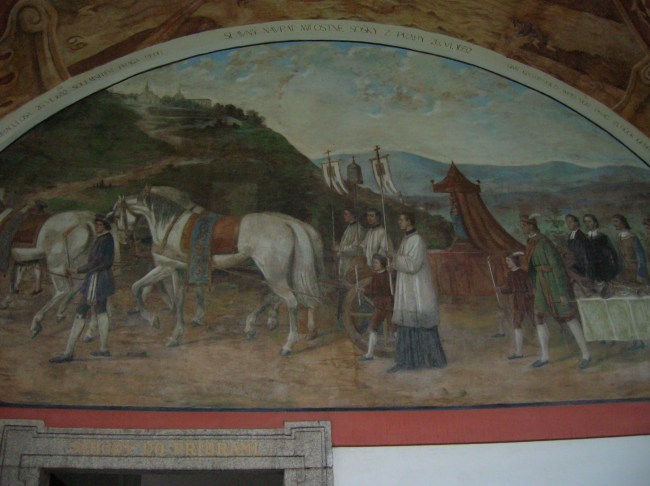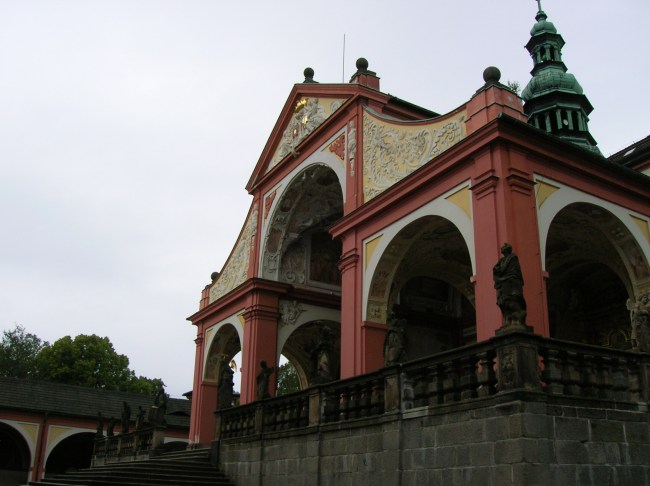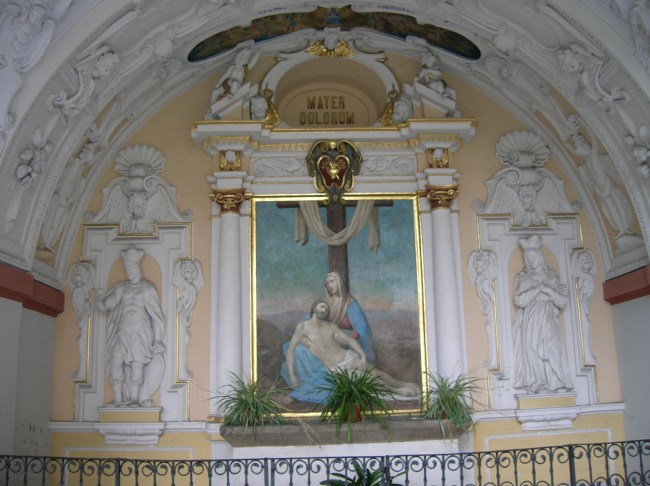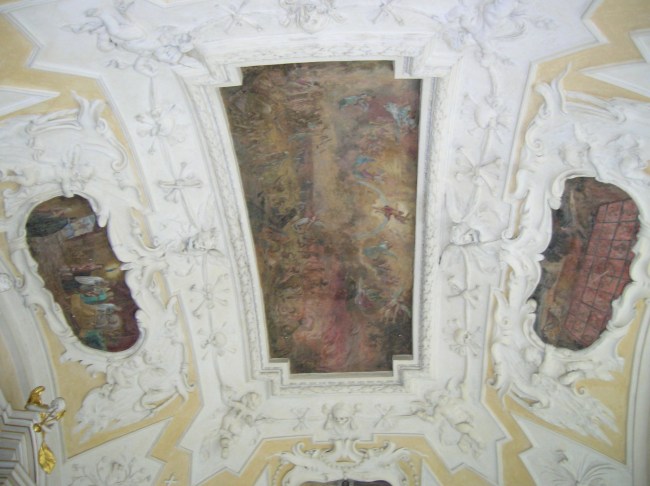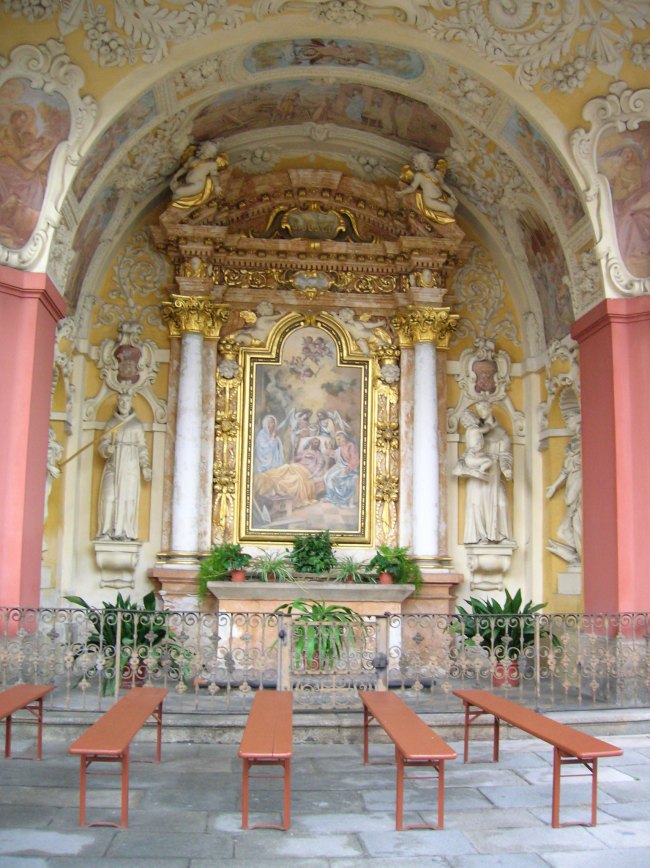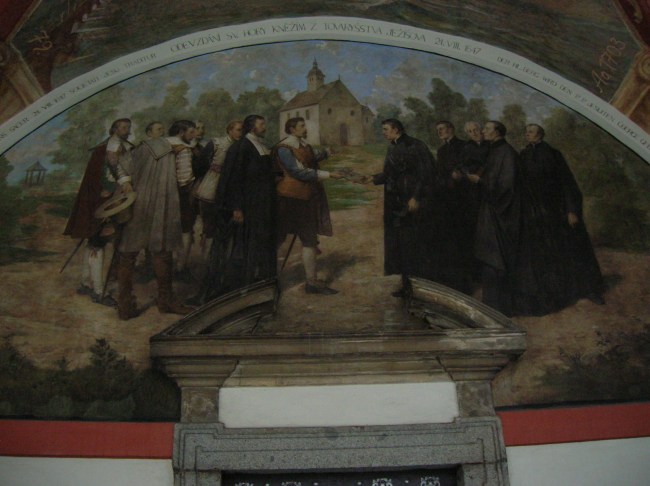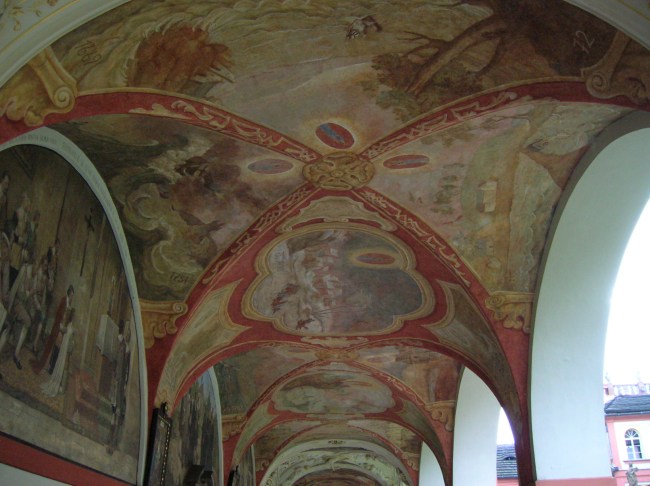I was excited. I was actually travelling to a chateau I had never been to. This was not a return visit after a 10 or 12-year absence. I had not even known that Slatiňany existed before I flipped through a book listing all the castles and chateaus in the land and came upon the page by accident. Then, at Žleby Chateau, I heard the chateau’s name connected to the Auersperg family, who owned both properties for more than 200 years.
This time I had to change trains at Pardubice, an hour from Prague, and then I had about 20 minutes before the next train. For the first time I took the Student Agency Regio Jet and found that company’s trains to be just as comfortable and relaxing as their conspicuous yellow buses. Student Agency got me to Pardubice on time, a little after 8:30. I had time to use the public restroom at Pardubice’s train station and was surprised that at the station of a relatively good-sized city the toilets did not flush. But I guess that is just life traveling through the Czech Republic.
I caught the local train – a new one with a clean interior – without any delay and was in Slatiňany in about half an hour. From the miserable little train station there, it was a short, straight walk to the chateau. I arrived there a bit before 10 am, when the place would open. I admired the side of the chateau facing the walkway. It was white with painted squares that reminded me of the Renaissance sgraffito façade of Litomyšl Chateau, though it was not at all that extravagant.
 I also had time to take a peek at the small church nearby. Very quaint and intimate, it was designed with a partial rotunda. I peered through the open door, but it was dark inside. Still, I did make out a stunning altarpiece and some impressive paintings. I would have loved to go inside this church because the intimate atmosphere of the small, relatively plain but compelling interior made me feel at ease. It seemed to be a good place to meditate about life and its problems.
I also had time to take a peek at the small church nearby. Very quaint and intimate, it was designed with a partial rotunda. I peered through the open door, but it was dark inside. Still, I did make out a stunning altarpiece and some impressive paintings. I would have loved to go inside this church because the intimate atmosphere of the small, relatively plain but compelling interior made me feel at ease. It seemed to be a good place to meditate about life and its problems.
At 10:00 am I entered the courtyard of the chateau. A statue with natural rock at its base showed off a small sculpture of a man on a horse. At the ticket office I paid for a ticket to the chateau interior exhibition – there was also a hippology tour – and bought a guidebook. I read about the background of the chateau while I waited for the caretaker give the tour.
At the end of the 13th century, a medieval fortress had stood on this spot, and the first owner, František of Slatiňany, managed the stronghold from 1294 to 1297. One of the later medieval owners even had a claim to fame. Václav of Slatiňany had been one of the signatories on a petition arguing against killing Jan Hus, who was accused of heresy against the Catholic Church and burned at the stake in July of 1415. (Hus was a key player in the development of the Protestant movement.)
Slatiňany was destroyed by fire several times. When Bohuslav Mazanec of Frymburk purchased the medieval fortress in 1575, he began to give the place a Renaissance makeover, and the renovations continued after his death in 1589. Not only was the chateau designed in Renaissance fashion but a mill, vineyard, brewery and malt house were also added.
A turning point in Slatiňany’s history came when Josef František, Count of Schönberg, bought the chateau in 1732 and had it rebuilt in Baroque style. A key event occurred when his only daughter, Marie Kateřina, married Jan Adam of Auersperg in 1746.
Then the chateau became the property of the Auersperg family, who would rule here for 200 years, until World War II. The chateau got its present appearance from 19th century renovations during the Auerspergs’ tenure here. In 1942 the chateau became the property of Dr. Josef Karel Trauttmansdorff, who was from an Austrian noble family. After the war, it was nationalized, according to the Beneš decrees, which took away property possessed by Germans during the war. Since Trauttmansdorff had been Austrian, his properties had to be nationalized, the decrees declared.
 In the tiny entranceway hung portraits of horses – there was a horse farm and a hippology museum on the chateau land as well. Another black-and-white portrait showed a bald, distinguished looking mustached man who the guide referred to as the popular and significant František Josef, Count of Schönberg. A bison featured prominently on the family’s coat-of-arms that was placed above the portrait. The caretaker explained that this is where the Auerspergs had lived – it was a sort of family home – as opposed to Žleby Chateau, which functioned more as a museum for all those weapons and tiled stoves among its monumental interior. Three of František Josef’s five children were born here – Kristína, Karolína and Ferdinand.
In the tiny entranceway hung portraits of horses – there was a horse farm and a hippology museum on the chateau land as well. Another black-and-white portrait showed a bald, distinguished looking mustached man who the guide referred to as the popular and significant František Josef, Count of Schönberg. A bison featured prominently on the family’s coat-of-arms that was placed above the portrait. The caretaker explained that this is where the Auerspergs had lived – it was a sort of family home – as opposed to Žleby Chateau, which functioned more as a museum for all those weapons and tiled stoves among its monumental interior. Three of František Josef’s five children were born here – Kristína, Karolína and Ferdinand.
The guide also emphasized that Slatiňany was a modern chateau. There had been heaters in the place since 1925. A boiler room, a dumb waiter and flushing toilets also made up the modern conveniences. As the guide opened a door off the entrance that had once led to the park and now contained many plants, he mentioned that in the mid-19th century there had been tennis courts, a small house for dolls and a small chapel on the grounds. Now there was only a small chapel and lake in the impressive park that features many kinds of trees.
We walked up the small, narrow main staircase after putting on house slippers. Upstairs the pristine-looking, white hallway boasted pink chairs plus two tables with green and white décor and brown tops. White, porcelain horses manned by riders in hunting dress were featured in a display case. I was entranced with a mirror’s frame – it was silver but also with pink and light blue decoration. The room was indeed modern with its radiators and porcelain light switch. The pictures in the room showed views of Vienna. I immediately spotted the Graben with its Plague Column.
 The next room was used for official visits, the guide said as he expounded on the family members in the portraits. I was also very interested in the history of the objects in the small room with many items. The first thing I noticed when I entered the room, however, was not an object but rather a smell – the stench of horse dung. Horses grazed nearby on the property, and the windows were open. I tried to concentrate on the details all around me. Maroon chairs and a couch made the space look cozy, and brown bureaus seemed to include intarsia. I admired the mirror with the ornate gold frame – it had to be Rococo. The doors and walls were white with gold décor, giving the place a light and airy feel that contrasted in a positive way with the maroon color. I also admired a red, white and blue bowl on a brown table.
The next room was used for official visits, the guide said as he expounded on the family members in the portraits. I was also very interested in the history of the objects in the small room with many items. The first thing I noticed when I entered the room, however, was not an object but rather a smell – the stench of horse dung. Horses grazed nearby on the property, and the windows were open. I tried to concentrate on the details all around me. Maroon chairs and a couch made the space look cozy, and brown bureaus seemed to include intarsia. I admired the mirror with the ornate gold frame – it had to be Rococo. The doors and walls were white with gold décor, giving the place a light and airy feel that contrasted in a positive way with the maroon color. I also admired a red, white and blue bowl on a brown table.
The following room was used for unofficial visits. Facing me was a huge picture of a rider on a horse with a blue landscape and trees in the background. I stood near a brown dresser with intarsia and noticed a desk with intarsia, too. The rocking horse looked as if it had real horse hair for its mane. The white with gold tiled stove had a decorative gold jug on its top. In a portrait Vilemína Auersperg, František Josef’s wife, was clad in a black dress and pearls. Blue and white porcelain also featured prominently in the room as did a picture of a one-year old František Josef.
The bedroom included a lovely white desk with a white chair partially covered with lace. Religious paintings decorated the back of the bed. The white tiled stove with the blue décor had to be Rococo. Black-and-white engravings covered one wall. I noticed a quaint family scene with a mother, child and dog in one picture. Vilemína’s daughter Kristína had been born in this room on November 11, 1878. There were two secret doors in the space. One hid a flushing toilet. Behind the other was a toiletry corner with porcelain items that bore the stylized A for Auersperg. The guide showed us a small, elongated bowl from Karlovy Vary. What was it for? Women were supposed to urinate in it. Another narrow, elongated porcelain case was made for a toothbrush.
 In the Small Dining Room there was no table. However, there was a huge chandelier made in Murano. Hailing from the 18th century, the lavish light fixture boasted green, pink, blue and white glass, with blue and white flowers and green leaf formations. A compelling tapestry depicted a scene in nature with a sculpture in the middle of a fountain. I was especially fond of the black-and-white jewel chest across from me. The grandfather clock had a beautiful, gold face. Black-and-white engravings with landscape scenes and portraits of animals covered the walls of the adjacent study.
In the Small Dining Room there was no table. However, there was a huge chandelier made in Murano. Hailing from the 18th century, the lavish light fixture boasted green, pink, blue and white glass, with blue and white flowers and green leaf formations. A compelling tapestry depicted a scene in nature with a sculpture in the middle of a fountain. I was especially fond of the black-and-white jewel chest across from me. The grandfather clock had a beautiful, gold face. Black-and-white engravings with landscape scenes and portraits of animals covered the walls of the adjacent study.
Bookshelves lined two walls of the library, and there was a secret door in a bookcase. In one photo Ferdinand, František Josef’s youngest son and the last of the Auersperg clan, looked like a member of the Mafia in a bowler hat. The caretaker remarked that very few people had attended Ferdinand’s funeral in 1942.
The Big Dining Room was dominated by a painting that was longer than the wall on which it was hung. It depicted red coat-clad hunters preparing for a hunt as the hounds played in one corner, the background filled with a lush, green landscape. Dark green cups of various sizes stood out among the tableware. The white tiled stove boasted brown flower buds and green leaves.
Then we went down to the kitchen in the cellar. On a high shelf white with brown vases boasted the Auersperg A. We also went into the boiler room, though the small and big boilers were no longer functional. The technology of the boiler room hailed from the First Republic in Czechoslovakia during the early 20th century.
 There was also a museum of hippology at the chateau, though I did not have time to visit it. The founder of Czech zootechny and prominent geneticist František Bílek had founded it. After World War II, during 1945, there were not suitable stables or pastures for all the horses in the area, so some were sent to Slatiňany, where there were vast grasslands and stables built by the Auerspergs at the end of the 19th century. Because there was a hippological tradition in eastern Bohemia, Professor Bílek decided to base the museum here. It included three sections: three representative rooms, five rooms of a scientific section and an exhibition of the horse in art. The scientific section focused on paleontology, zoology, anatomy and domestication. Another part centered on how the horse contributed to culture and society. The exhibits come from 122 Bohemian and Moravian castles and chateaus. The segment featuring the horse in art forms opened in 1950 while the scientific section was inaugurated two years later.
There was also a museum of hippology at the chateau, though I did not have time to visit it. The founder of Czech zootechny and prominent geneticist František Bílek had founded it. After World War II, during 1945, there were not suitable stables or pastures for all the horses in the area, so some were sent to Slatiňany, where there were vast grasslands and stables built by the Auerspergs at the end of the 19th century. Because there was a hippological tradition in eastern Bohemia, Professor Bílek decided to base the museum here. It included three sections: three representative rooms, five rooms of a scientific section and an exhibition of the horse in art. The scientific section focused on paleontology, zoology, anatomy and domestication. Another part centered on how the horse contributed to culture and society. The exhibits come from 122 Bohemian and Moravian castles and chateaus. The segment featuring the horse in art forms opened in 1950 while the scientific section was inaugurated two years later.
I was sorry I did not have time to tour the second exhibition, but I had to have lunch and catch two trains back to Prague before the evening. I had to admit that horses had never been my cup of tea, but the tour sounded exciting nonetheless. Instead of waiting around, I found a restaurant with an inconspicuous sign on the main street. The interior, though, was delightful. Some backs of chairs were carved as figures of knights. Others featured coats-of-arms. My chair had a picture of a reindeer on it. The restaurant was dark with an almost romantic ambience, though the loud children were hardly romantic. The chicken was delicious as was the honey cake I had for dessert.
Then I headed for the dingy train station, and the train arrived soon. I was facing a dilemma, though. If this local train was on time, I would have seven minutes to change trains to Prague at Pardubice. If not, I would have an hour and a half to kill at the train station without flushing toilets. Even the chateau interior from the First Republic had flushing toilets! Why couldn’t the ones at the train station flush?
The local train did not let me down, and I was glad because I had to go to the bathroom. I made my connection in seven minutes, and I have never been happier to use a toilet on a train.
Tracy A. Burns is a writer, proofreader and editor in Prague.


















